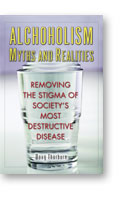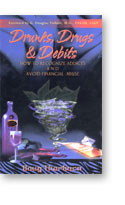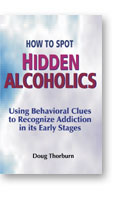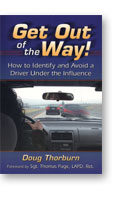 |
| January 2006 / Issue No. 17 |
|
Welcome to the Thorburn Addiction Report. Each month, we bring you several sections, including:
1. Top Story of the month
2. Review-of-the-Month
3. Dear Doug in which a recent letter to "Dear Annie" or other "help" column is rewritten, with responses given from the unique perspective that alcohol or other drug addiction best explains the misbehaviors described
4. Alcoholic Myth-of-the-Month
5. Alcoholic Antic-of-the-Month
There is something for everyone!
|
|
Competition Freaks, the Super Bowl and Alcoholism
 The link between winning and alcoholism proves elusive for the media The link between winning and alcoholism proves elusive for the media
In a recent piece in the Los Angeles Times, “Competition Freaks,” writer Marianne Szegedy-Maszak addressed the question of what motivates those who just have to win. By the fourth paragraph, she connected out-of-control soccer moms screaming at referees, those banned from playing family board games because they ruin the entire evening when they lose, obsessive compulsive disorder, narcissism, road rage, drunk driving and addiction. Hoping she would explore the connection further, I looked for more mentions of DUI or alcohol/other-drug addiction somewhere—anywhere—in the following 48 paragraphs. Alas, I looked in vain.
In asking, “How many people do we walk over to be successful?” and “When is this kind of competition admirable, and when is it pathological?” the piece failed to forge the link between pathological behaviors and alcohol/other-drug addiction. While Szegedy-Maszak mentioned numerous exceptions to professional tennis player Lea Antonopolis-Inouye’s observation that “the most successful athletes that I have known have absolutely no irrational competitiveness,” she failed to consider the possibility that the difference between the rational and irrational is, in most cases, attributable to alcoholism. Szegedy-Maszak also neglected to advance the idea that those described by Denis Waitley, former chairman of psychology for the U.S. Olympic Committee’s Sports Medicine Council, as “take no prisoners competitors [who] can be very successful much more rapidly than win-win competitors,” may be driven by alcohol-fueled egomania.
Szegedy-Maszak pointed out that there’s a story almost every day “about a hyper competitor dragging a company, or a team, or simply himself into a terrible mess.” She described the behaviors of a number of such competitors, including Philadelphia Eagles wide receiver Terrell Owens, Oakland Raiders defensive back Jack Tatum and former chief executive Albert J. Dunlap. Owens recently complained about a lack of recognition for his 100th career touchdown, stormed into the locker room and challenged his fellow teammates to a fight. In 1978 Tatum not only didn’t apologize for turning another player into a quadriplegic by hitting him; he justified his action saying, “It was a clean hit.” Dunlap earned the name “Chainsaw Al” while chief of Sunbeam Corp. by firing thousands of employees capriciously, demeaning anyone who disagreed with him and driving his $1 billion company into bankruptcy. Never once did she suggest the likelihood that these irrational behaviors might be rooted in brain damage caused by alcoholism. Instead, we’re left to believe that these are just stupid or awful people. I doubt it.
The example of Ty Cobb, arguably the greatest baseball player ever and a full-blown alcoholic throughout his entire career, baffled me well into the writing of the first draft of my first book, Drunks, Drugs & Debits. The overachieving addict—the highly functional, early-stage alcoholic—became comprehensible only when author James Graham, who had followed in the much earlier footsteps of Dr. Harry M. Tiebout, M.D., connected egomania and the need to wield power over others to alcoholism. Egomania, in turn, was explained by author Vernon Johnson’s observation that alcoholics recall everything they do or say through self-favoring lenses. I realized this must feed on itself, fueling egomania. Graham pointed out that alcoholics tend not to deteriorate into latter-stage alcoholism as long as they are able to successfully inflate their egos. Successful ego inflation drives achievement because there is no more efficient way to insure that others will follow and adulate, allowing the addict to control others with their blessing.
Professional sports often provide the best evidence for this phenomenon. Yet few observers have a clue that professional athletes, who by definition must be superb human specimens physically and mentally, may ironically be driven by alcoholism—the same addiction that will eventually destroy them.
Some examples of extraordinary pro-football players in which alcoholism likely exists include:
• Denver Broncos quarterback Brian Griese, who pleaded guilty to a DUI in 2000 and more recently fell while attending a party, slamming his head into a driveway and knocking himself unconscious. While he claimed it was an accident, a teammate is reported to have confided that Griese “was undone by alcohol, a fist fight, a black eye, a chipped tooth, and seven stitches.”
• Former Raider’s linebacker Bill Romanowski, who agreed to pay former teammate Marcus Williams $415,000 after hitting him in the face.
• Former New York Jets quarterback “Broadway Joe” Namath, who got sober in 1987, relapsed in 2000 and headed back to AA meetings in 2004; Namath loved the company of blondes and Johnnie Walker long before the start of his pro career.
• Raiders’ starting center Barret Robbins, who may have drank “normally” for a time while in high school because, at 300 pounds, he would have required far more alcohol than is typical to trigger alcoholism. Yet, he was nicknamed the “Asshole” by teammates in his rookie year for becoming surly when drinking; he was described as two different people—the good guy Dr. Jekyll and the Asshole Mr. Hyde. In what could be one of the most tragic cases of misdiagnoses ever, doctors determined he was clinically depressed and prescribed medications. He was later diagnosed as not having depression but rather bipolar disorder, which requires different medications. There is no report until 2003 that anyone told him he had the disease of alcoholism, which may explain, and at the very least seriously exacerbates, his bipolar disorder. Nor is there any evidence that anyone, including his wife who at one point agreed to ”monitor his consumption” when he resumed drinking after a hiatus, attempted to coerce abstinence. He completely unraveled two days before he was scheduled to appear in 2003’s Super Bowl XXXVII, when he went to a bar, bought rounds for everyone and ended the bender in Tijuana. The Raiders, while not doing him any favors by keeping his erratic behaviors quiet, were reportedly aware of Robbins’ “mental problems” since 1996.
• Former Cleveland Browns running back Jim Brown who, after a long history of arrests for alleged attacks on women, was finally convicted in 1999 at age 63 for smashing his 25-year-old wife’s car with a shovel. He was ordered into anger management counseling but not required to refrain from drinking or using. His wife recanted allegations that he threatened to snap her neck. (As an aside, alcoholism is common in one or both spouses of markedly different ages, increasing as the difference widens, particularly beyond 15 years. Marrying someone much older or younger is ego-inflating.)
• New York Giants quarterback Kerry Collins, who admits to drinking alcoholically at age 13. After being sacked for a series of inappropriate incidents including making allegedly racial slurs, he was arrested for DUI, which he says was a turning point in his life.
• Jacksonville Jaguars’ first-round pick in the 2000 draft R. Jay Soward, who quickly watched his career crumble, drinking “a fifth of Hennessy and a fifth of Alize” from 6 a.m. all day, every day. Soward says the “best thing to happen to me” was being banned by the NFL indefinitely in 2002, which apparently instilled in him a need to get sober. However, in a bizarre stunt suggestive of impending or actual relapse, he recently finished his second season in the Canadian Football League by catching a 43-yard touchdown pass for the Toronto Argonauts and stopping at a concession stand near the end zone for a bag of popcorn—only to watch the opposing Montreal team rally from behind and win.
• 1997 Heisman Trophy winner and four-time Pro Bowl cornerback Charles Woodson, who was arrested for public intoxication following a Raiders’ victory over the Tennessee Titans in December 2004 and for a DUI in 2000, with a blood alcohol level reported at .24 per cent.
• Lawrence Phillips, described in the Los Angeles Times as “one of the best running backs ever at the University of Nebraska, and one of the greatest busts in the National Football League,” recently arrested for allegedly driving into a crowd of teenagers whom he accused of stealing his wallet. He was driving his live-in girlfriend’s car, which he had allegedly stolen after battering her. The St. Louis Rams chose him as their first-round pick in the 1996 draft, even with a pre-draft psychological evaluation that identified “maturity” issues. Shortly after, he was charged with DUI while driving at 78 mph on a flat tire with a blood alcohol level at about .16 per cent. After “giving up” alcohol in 1999, the “maturity” issues that re-surfaced suggest he suffered a severe relapse. As early as 2000, he was charged with attacking a girlfriend and ordered to take anger-management classes. Friends have been unable to reconcile his public misbehaviors with a man they describe as often charming, smart and generous. There is no mention of Phillips ever having been told, “You have the disease of alcoholism, which drives your anger. Therefore, you are proscribed from drinking, and here are the consequences if you violate the rule.”
While watching the upcoming Super Bowl, keep in mind that there may well be players on both sides whom we enable by providing the demand and paying for their talents. We should ask their teammates and managers to do everything in their power to prevent the otherwise inevitable slide into the abyss of addiction by setting and enforcing a basic rule: for anyone whose behaviors indicate alcoholism, he must test clean to play.
Runners-up for top story of the month:
Kevin Federline, who was allegedly dumped by new-mom Britney Spears because of his continuing marijuana use and reversion to partying and nightclubbing. Federline is reported to have recently been arrogant, rude and critical of Britney in front of others. (Let’s see…pompous, inconsiderate behaviors and making disparaging remarks…How to Spot Hidden Alcoholics mentions these and other behaviors as indicative of early-stage alcoholism.) Britney had a prenuptial agreement requiring that she pay Federline, who was unemployed when they met, $300,000 for every year they stay married. Anyone who’d care to send Britney my books will help save her a lot of money….(although she was smart…it could have been far worse.)
Purported good-girl actress Kirsten Dunst, admitting to Jay Leno that she has “lots of alcohol and no food” in her fridge, and “jokingly” responding to Leno’s query as to whether she might have a “problem,” “…maybe in a few months you’ll see me in…rehab…” In what may be a case of late-onset alcoholism, Dunst, 23, is reported by friends as having “gone from good girl to she-devil overnight…out almost every night of the week with a gang of party crazy pals.”
Actor Vince Vaughn who, after being spotted driving erratically and weaving in and out of traffic, was forced to take a sobriety test because he reeked of booze, and the enabling Arizona police who would neither arrest nor allow him or passenger Jennifer Aniston to continue driving in their intoxicated states. Vaughn, who co-starred in The Wedding Crashers, was charged but not convicted for fighting during a club brawl in September 2001.
“Lost” actresses Michelle Rodriguez and Cynthia Watros, arrested by Hawaii police almost simultaneously for DUI after each was observed weaving. Rodriguez, who had sworn off partying and told “Lost” producers that she had changed, was jailed only last year for a series of driving misbehaviors, including a hit and run, driving with a suspended license and DUI. Watros co-starred in the very amusing alcoholic series “Titus” (a review of which can be found in the August 2005 issue of the Thorburn Addiction Report—link follows this article.)
Actor Lillo Brancato, 29, who starred in “A Bronx Tale” and “The Sopranos,” arrested on suspicion of second-degree murder, while his girlfriend’s father Steven Armento was arraigned on first-degree murder. The two engaged in a shoot-out with an off-duty police officer who confronted them after hearing glass break next door to his home. Brancato had two prior arrests, including a bust for heroin possession in mid-2005, while Armento has been in trouble with the law repeatedly since 1976.
Actor Brad Renfro, 23, arrested for attempting to purchase heroin in an LAPD sting operation on skid row in downtown Los Angeles. He first attracted attention in the 1994 John Grisham film version of “The Client” and later appeared in “Apt Pupil,” “Ghost World” and “Tom and Huck.”
Former Burbank, California councilwoman Stacey Jo Murphy, who pleaded guilty to felony cocaine possession after law enforcers connected her to a violent street gang. Murphy, a former PTA member who had a squeaky-clean reputation and whose close friends were described as “shocked and flabbergasted” at her arrest, entered a plea agreement with no jail time in exchange for enrollment in drug and parenting classes with progress reports. If her friends and colleagues were aware of the numerous behavioral clues to addiction detailed in How to Spot Hidden Alcoholics, they might have been in a position to intervene before her addiction got the best of her and wouldn’t be so surprised. My guess is she was a recovering alcoholic who may have been influenced to fall off the wagon by cocaine-addicted boyfriend Scott Schaffer, who pleaded guilty to trading guns for cocaine with the notorious Vineland Boyz street gang.
Ex-USC Trojan star and Pro Bowl defensive tackle Darrell Russell and former teammate Mike Bastianelli, dead from injuries sustained in a one-car automobile accident. While the report of Bastianelli's death didn’t mention a toxicology report, he was driving a friend’s car at a “high rate of speed” at 6 a.m. Russell, chosen No. 2 overall by the Raiders after the 1996 season, signed a rookie record-breaking seven-year $22 million contract. During a five-year career with the Raiders, he was suspended by the NFL four times for substance abuse policy violations. In 2002, he was arrested but not convicted on charges of drugging and raping a woman and charged with DUI after leaving a brothel in Carson City, Nevada. Those who knew him described him as likeable and having a keen mind and sharp wit. He was also reportedly reared well by his mother, providing yet further support for the idea that an excellent environment can’t protect one from addiction. Both Russell and Bastianelli may be poster-children representing the tragic results of unchecked alcoholism.
Comedic actor Richard Pryor, dead from a heart attack after a long battle with multiple sclerosis. His drinking almost killed him two decades ago; he apparently sobered up after setting himself on fire while freebasing cocaine.
And finally, in the spirit of the holiday season, two obscure possible alcoholics tragically crossed paths: Gildardo Gudino Jr. of Bell Gardens, California, age 34, who tumbled out of a party bus limousine onto a Los Angeles freeway at 3:30 a.m. one Sunday in December, along with Albert Deleon, 48, who is accused of hitting the victim and fleeing the scene. Officers determined Deleon was driving while under the influence. It had not yet been determined whether the victim was already dead from hitting the pavement before being struck by Deleon. Gudino was celebrating his 34th birthday and had rented the party bus in an effort to avoid such a tragedy. On the other hand, he was long past puberty and fraternity hi-jinks, increasing the likelihood of alcoholism.
Under watch:
Former German chancellor Gerhard Schroder, who used his position to structure a deal supporting the construction of a controversial gas pipeline under the Baltic Sea. Shortly after stepping down as chancellor, he took a job reportedly paying over $1 million annually with the Russian energy giant Gazprom, chairing the pipeline consortium’s shareholder committee. While former chess champion and now contributor to The Wall Street Journal Garry Kasparov asks, “Does the state run Gazprom or does Gazprom run the state?” he failed to ask the questions, “What mindset might motivate Schroder to act in a manner that could raise such obvious concerns over improprieties?” and “what might that mindset be rooted in?”
Former Wal-Mart Vice Chairman Thomas Coughlin who, despite having been a protégé and former hunting buddy of founder Sam Walton and earning millions in compensation, pleaded guilty to five illegal transactions involving the misappropriation of more than $350,000. Documents reviewed by The Wall Street Journal suggest that through fraudulent reimbursements and improper use of gift cards he had the retailer pay for a variety of personal expenses, including a $2,590 dog enclosure, a $1,359 pair of alligator boots, several shotguns, wine and Stolichnaya vodka. It isn’t the purchase of alcohol that is suspicious in itself, but rather that he engaged in acts of deception and theft through guile, while earning millions of dollars. Note, however, that it will be practically impossible to obtain proof of addictive use by anyone outside his close circle, as is true for most CEOs and politicians who engage in gross misconduct: there is no National Enquirer for business and political leaders.
Note to family, friends and fans of the above: the benefit of the doubt is given by assuming alcoholism (they are either idiots and fundamentally rotten, or they are alcoholic/other drug addicts—which would explain the misbehaviors). If alcoholic, there is zero chance that behaviors, in the long run, will improve without sobriety. An essential prerequisite to sobriety is the cessation of enabling, allowing pain and crises to build. Thus far, many have done everything they can to protect the addict from the requisite pain, making these news events possible. The cure for alcoholism, consequential bad behaviors and, ultimately, tragedy, is simple: stop protecting the addict from the logical consequences of misbehaviors and proactively intervene.
Thorburn Substance Addiction Recognition Indicator
|
|
 Review: “My Name is Earl” Review: “My Name is Earl”
I admit to having seen this hilarious new TV show only a few times and to a gross failure to take notes. Hey, even I like to relax a bit sometimes.
For those few of you on Pluto who don’t know the storyline, Earl was hit by a car, survived, and realized that by spreading bad Karma he was often on the receiving end of it. The spreading of good includes not only reforming himself, but also paying amends to victims of his prior misbehaviors. He carries a list of some 260 amends he must make, of which he gets to cross off one per episode. Hopefully, we’ll get to see him right his wrongs for many years to come.
The writing, stories and acting are all very good, and the show is one of this season’s surprise hits (which NBC, the show’s home, badly needs). I suppose it wouldn’t be so popular if the writers made it clear that Earl’s metamorphosis couldn’t have “just happened” and that he must have stopped drinking for the “magic” of clarity to appear. But it would be refreshing and educational if, just once, they could mention the fact that Earl has the disease of alcoholism—and the cessation of drinking made good behavior possible, along with a need to pay amends to those he had previously harmed.
|
 |
Dear Doug: Closet Abuser
Dear Doug:
After 30 years of verbal, emotional and even occasional physical abuse, I have finally filed for divorce. I am looking forward to my new found freedom.
The trouble is that I have hidden the abuse all-too-well. Our friends and family, who see my husband as a wonderful, caring man, haven’t a clue. I look like the wicked witch and have already lost several 30-year friendships, along with his side of the family.
What should I do with people who judge me without knowing the real story?
Signed,
Closet Abused
. . . . .
Dear Abused,
Other columnists would say that if others were told the whole story, many would believe you. They’d essentially tell you to move on. And while that’s tempting, it would do nothing to solve the problem.
You have an opportunity to show other women what happens when they hide abuse and allow it to continue for decades. There is little doubt the abuse started shortly after you were married, if not before. You may have had children who suffered as well, who may be scarred and in need of counseling. The odds are 80-90% that your soon-to-be ex-husband has alcoholism, which is the root cause of the decades of misbehaviors.
If true, you have an opening to help others understand that if you had acted early in the marriage and nipped the alcoholism in the bud instead of divorcing in your 50s, you might still be happily married and looking forward to retirement with someone who may have been the love of your life. Since alcoholism tends to run in families, there is a greater likelihood of the disease in others on his side of the family than in the overall population. You can help a family at risk to grasp the idea behind the term, “tough love.”
Besides, why should you look like the cad? You’ve suffered long enough. While the subject of alcoholism will be difficult to broach, doing so will offer the possibility that something good will have come from your decades of suffering.
(Source for story idea: Annie’s Mailbox, December 7, 2005.)
|

“Authorities aren’t sure why Radzicki allegedly attacked the woman.”
So said Sheboygan, Wisconsin County District Attorney Joe DeCecco in describing an attack by Nathaniel S. Radzicki on his live-in girlfriend—with a cactus plant. According to the woman, Radzicki “went psycho. He acted like he was possessed, like he was the devil.” He faces felony battery charges for the attack, during which he also bit his unnamed girlfriend, leaving her “covered in blood.” She had half-inch cactus thorns stuck in her neck, face and arms that had to be removed by hospital personnel.
According to the complaint, Radzicki was upset over phone calls made earlier in the evening. Of course he had been, according to DeCecco, “drinking.” While there were no previous convictions for violent offenses, he was cited twice in June 2005 for disorderly conduct.
The comment by authorities is a common one. It is misleading because the bizarre behaviors are likely to be construed by the uninitiated as having been provoked by an argument or other disruption. Yet, the odds are very high that if he didn’t have the disease of alcoholism, whatever occurred during his phone calls would have been handled in a mature manner rather than an uncivilized one.
The correct explanation is probably, “Radzicki has alcoholism, which causes him to act destructively some of the time. His particular style took form, at least in this instance, in a bizarre attack on the woman who, when sober, he may well love.” Proper consequences should include jail time, but more importantly alcohol and other-drug testing for a number of years as a condition of early release and probation. Unfortunately, he’ll probably end up in prison, untreated and untested for his disease. And far greater tragedies may well occur in the life of Nathaniel S. Radzicki and the lives of those who are unlucky enough to come into contact with him.
|

Amazing Antics: Stories of Alcoholism-Driven Behaviors™
Stories from “This is True” by Randy Cassingham, with his “tagline:”
In the spirit of the holiday season, even though it didn’t occur during the holidays, here’s a classic from August 18, 2002:
“MADE FOR EACH OTHER: A sheriff’s deputy stopped a car in Spring Creek, Nev., after it nearly hit his patrol car. As he was pulling the car over, another car nearly hit him—and he got it stopped too. The first car was driven by Lynn Allen White, 31. Deputy Sean Murphy arrested him for drunk driving. The second car was driven by Denean Veronica White, 36—the first driver’s wife. She also failed sobriety tests and was also arrested for drunk driving. (AP) '…Watch your back, Deputy Murphy: their kids may have cars soon.'”
How true. Unfortunately, the odds of alcoholism in a child of an alcoholic are roughly four times that of children of non-alcoholics. And it also points to the danger that law enforcers accept by virtue of their job: roughly 2% of road miles are driven by alcoholics while under the influence, who cause almost 50% of road carnage. While cops spend much of their working careers on the road protecting the rest of us, they put themselves in the greatest danger.
And another in the spirit of the holiday season, from October 27, 2002, again proving that alcoholics don’t need no stinkin’ holiday to get drunk:
“SAFETY FIRST: Police in Ontario, Canada, are on a campaign to ensure motorists wear their seatbelts. They stopped a car in Mississauga after seeing a child unrestrained in the back. The officer found the child couldn’t be belted in because the seatbelt was already in use—to secure a case of beer. ‘It was like this guy cared more for his precious beer bottles getting smashed than he did for his son going through the windshield,’ an officer said. (Mississauga News)
'...Correct.'”
That says it all.
(Stories and taglines from “This is True,” copyright 2002 - 2006 by Randy Cassingham, used with permission. See http://www.thisistrue.com for free subscriptions.)
Visit www.thisistrue.com for free subscriptions.
|
Comments
To view reader's comments on last month's Thorburn Addiction Report and Doug's responses please visit the Thorburn Weblog at PrevenTragedy.com.
Doug frequently posts alcoholism-related articles, as well as his responses, so be sure to check back often.
Thorburn Weblog
|
Doug's new book, Alcoholism Myths and Realities, is now available at
GaltPublishing.com, Amazon.com and bookstores near you.
"Every policymaker in America needs to read your book exposing the myths of chemical addiction...Excellent book."
— Jim Ramstad, Member of U.S. Congress (MN)
"My father died of alcoholism. His father died of alcoholism. Three generations of alcoholism is enough. Now is the time to abandon superstition and pseudoscience, to debunk the myths surrounding alcoholism, and to apply science to solving this problem. Doug Thorburn's book is a model example of how this should be done. Read it and be prepared to change your thinking on this important topic. When enough of us understand what is really going on with alcoholism, society can make the shift from treatment to prevention and intervention."
— Michael Shermer, publisher, Skeptic Magazine and columnist, Scientific American
Buy your copy of Alcoholism Myths and Realities for only $14.95 or get the whole collection PLUS a two-hour audio cassette from Galt Publishing for just $49.95 plus tax and shipping. That's a $72.75 value for only $49.95.
To order online, click the following link (be sure to put "TAR SPECIAL" in the comments section of the order form.) Orders can also be placed by phone: 800-482-9424 OR fax: 818-363-3111.
If you wish to pay by check, send the appropriate payment with your shipping information and the words "TAR SPECIAL" in the "memo" section of your check to: PO Box 7777, Northridge, CA 91327.
To purchase any of the above Thorburn books, go to www.galtpublishing.com |

Have you visited the Prevent Tragedy Foundation? The Prevent Tragedy Foundation is a tax-exempt 501c-3 organization, the goal of which is to educate the general public on the need for early detection of alcohol and other drug addiction. The Foundation is intended to answer a question that has been all-but-ignored by similar organizations: what does alcoholism look like before it becomes obvious?
Click here to visit the Prevent Tragedy Foundation |
|
Subscriptions
The Thorburn Addiction Report is a free newsletter published by Galt Publishing and PrevenTragedy.com. Subscibe by visiting our web site at www.PrevenTragedy.com.
Click here to visit PrevenTragedy.com
|
The Thorburn Addiction Report is available to newspapers as a regular feature column.
Inquiries are invited.
Copyright 2006 Doug Thorburn All Rights Reserved.
ALL broadcast, publication, retransmission to e-mail lists, WWW or any other copying or storage, in any medium, online or not, is strictly prohibited without prior written permission from the author. Manual forwarding by e-mail to friends is allowed if 1) the newsletter is forwarded in its entirety and 2) no fee is charged. Please forward no more than three issues to any one person -- after that, they should get their own free subscription. We appreciate people who report violations of our copyright to us.
TO COMMENT to the author,
send your email to report@preventragedy.com or write to
Doug Thorburn, P.O. Box 7777, Northridge, CA 91327-7777
|
 |





 Review: “My Name is Earl”
Review: “My Name is Earl”



